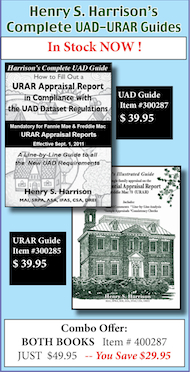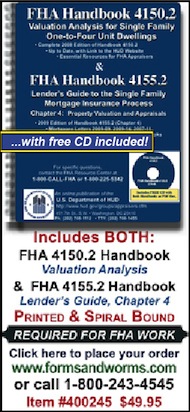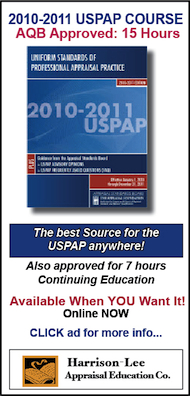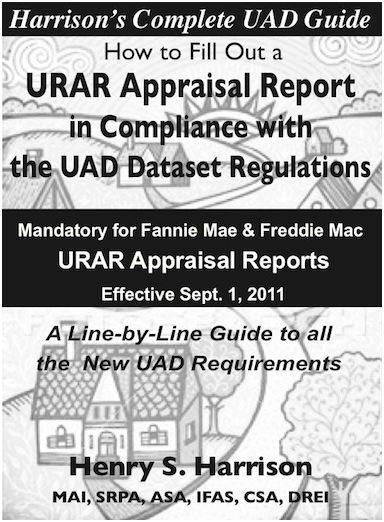Interview with Henry S. Harrison
The UAD is Coming! THE UAD IS COMING!
Interview with Henry S. Harrison
by his wife Ruth Lambert, Editor, Real Estate Valuation Magazine Online
Henry - can you explain to our readers what you are working on now?
Henry (H2): For the past few weeks, we have been very involved with the birth of our 5th grandchild, Sterling Harrison Muchnick, born February 23rd. Now I am back at work on my latest book "Harrison's Complete UAD Guide for the URAR."
What is the UAD? How will it affect appraisers?
H2: According to Fannie Mae and Freddie Mac (aka the GSEs), they "have developed the Uniform Mortgage Data Program (UMDP) to enhance the accuracy and quality of loan data delivered to each GSE. The Uniform Appraisal Dataset (UAD) is a key component which defines all fields required for an appraisal submission on one of four standard appraisal forms, and standardizes definitions and responses for a key subset of fields." What this means is that soon Fannie and Freddie will no longer accept appraisals on paper — only electronic transmissions from the lenders. In addition, they will require that all these appraisals be formatted exactly as delineated in the UAD, or their computers will reject them.
Interview with Henry S. Harrison
by his wife Ruth Lambert, Editor, Real Estate Valuation Magazine Online
Henry - can you explain to our readers what you are working on now?
Henry (H2): For the past few weeks, we have been very involved with the birth of our 5th grandchild, Sterling Harrison Muchnick, born February 23rd. Now I am back at work on my latest book "Harrison's Complete UAD Guide for the URAR."
What is the UAD? How will it affect appraisers?
H2: According to Fannie Mae and Freddie Mac (aka the GSEs), they "have developed the Uniform Mortgage Data Program (UMDP) to enhance the accuracy and quality of loan data delivered to each GSE. The Uniform Appraisal Dataset (UAD) is a key component which defines all fields required for an appraisal submission on one of four standard appraisal forms, and standardizes definitions and responses for a key subset of fields." What this means is that soon Fannie and Freddie will no longer accept appraisals on paper — only electronic transmissions from the lenders. In addition, they will require that all these appraisals be formatted exactly as delineated in the UAD, or their computers will reject them.
What four forms do these new UAD requirements affect?
H2: The URAR, the 'Individual Condominium Unit', the Exterior-Only Inspection Individual Condominium Appraisal Report' and 'Exterior-Only Inspection Residential Appraisal Report'.
When is all this going to happen? What is the timeframe for compliance?
H2: Some of the software vendors could not meet the original proposed effective dates. As of 2/18/2011, the Fannie Mae website (www.efanniemae.com) states: "For appraisals with an effective date (date of inspection) on or after September 1, 2011, the appraisal report must be completed in compliance with the UAD for conventional mortgage loans sold to Fannie Mae or Freddie Mac."
How are appraisers going to be able to comply with the UAD?
H2: That's an important question. I've heard from some very reliable sources that the webinars and other educational presentations about the UAD are teaching that all the information appraisers need is contained in Addendum D, available on the Fannie Mae website. I downloaded this document and found it contained this statement: "Instructions and requirements for these UAD-supported appraisal report forms are included in this document." I also downloaded an annotated copy of the URAR form, which has a number in each place on the form for which there is a UAD requirement or instruction regarding how the line should be completed, or a check box answer provided.There are about 220 of these numbered checkboxes and lines just on the first pages of the URAR. I discovered there are many other checkboxes and lines on the URAR that are not covered by the instructions in Addendum D.
That seems like a lot of confusing instructions! What did you determine?
H2: I already knew I wanted to write a guide on how to comply with UAD. The next big problem I encountered was that the Addendum D instructions are not keyed to the numbers on the form. Instead, they are grouped together by subject matter. Furthermore, instructions for several numbers are also grouped together; it wasn't clear at all which instructions applied to which numbers!
What did you do?
H2: I decided to see if I could find more precise line-by-line instructions, which I assumed would be needed by software developers. On the Fannie Mae website, I finally found "Appendix A: GSE Appraisal Forms Mapping". This is a 241 page legal-size instruction sheet intended for computer programers, that gives instructions for each numbered item on the URAR needed to comply with UAD. For example, I learned that some of the check boxes on the URAR are to be filled out with an "X" if they are applicable, and left blank if they are not applicable. Other check boxes are to be filled out if applicable with a "Y" or if they do not apply, with an "N".
How did all this affect your plans to write a guide?
H2: When I started on this project, I was planning to simply update my current Illustrated Guide to the URAR — which has had 40 printings since I wrote it in 1975, and has sold several hundred thousand copies. However, I soon realized that the project would take me many months. I decided that appraisers needed something a lot sooner!
Can you tell our readers more about your progress and plans regarding this project?
H2: Together with my son, H Alex (also REV Magazine's Webmaster), we are now completing 'Harrison's Complete UAD Guide for the URAR'. This guide is designed like my URAR Illustrated Guide. It follows the URAR form line-by-line, from start to finish. It gives the appraiser complete information about all the UAD "Requirements", "Instructions", "Formatting Requirements" and "Required Consistency Checks", as well as the maximum number of characters accepted, etc. It is a combination of the information I found in UAD Addendum A and UAD Addendum D. It is designed as a stand-alone book that supplements my URAR Illustrated Guide. It does not duplicate it.
How and where can appraisers obtain a copy?
H2: H Alex and I are hopeful that the new UAD books will be available for shipping before the end of April. The regular price will be $39.95, but currently there's a pre-publication discount of $5, so the price before April 30th is $34.95. The Discount Code is: $5PPUAD Orders will be shipped in the order they are received. We also have a special combo offer of the Complete UAD Guide plus the current URAR Illustrated Guide for $49.95, with the same pre-publication $5 discount (Code: $5PPUAD), for a selling price of $44.95.
They can be pre-ordered now from Forms and Worms at www.formsandworms.com or by calling Toll Free: 1-800 243-4545.
Do you have any advice for appraisers who are worried about complying? Or those who are not?
H2: Don't panic, but don't be an ostrich and hide your head in the sand, either. The UAD is a big change you must adjust to. It is not going to go away. According to Fannie Mae and Freddie Mac, they will not accept any URAR appraisals with an effective date of September 1, 2011 or thereafter that does not fully comply with these requirements. Compliance is going to take some getting used to. Our new UAD Guide will make it much easier!
H2: The URAR, the 'Individual Condominium Unit', the Exterior-Only Inspection Individual Condominium Appraisal Report' and 'Exterior-Only Inspection Residential Appraisal Report'.
When is all this going to happen? What is the timeframe for compliance?
H2: Some of the software vendors could not meet the original proposed effective dates. As of 2/18/2011, the Fannie Mae website (www.efanniemae.com) states: "For appraisals with an effective date (date of inspection) on or after September 1, 2011, the appraisal report must be completed in compliance with the UAD for conventional mortgage loans sold to Fannie Mae or Freddie Mac."
How are appraisers going to be able to comply with the UAD?
H2: That's an important question. I've heard from some very reliable sources that the webinars and other educational presentations about the UAD are teaching that all the information appraisers need is contained in Addendum D, available on the Fannie Mae website. I downloaded this document and found it contained this statement: "Instructions and requirements for these UAD-supported appraisal report forms are included in this document." I also downloaded an annotated copy of the URAR form, which has a number in each place on the form for which there is a UAD requirement or instruction regarding how the line should be completed, or a check box answer provided.There are about 220 of these numbered checkboxes and lines just on the first pages of the URAR. I discovered there are many other checkboxes and lines on the URAR that are not covered by the instructions in Addendum D.
That seems like a lot of confusing instructions! What did you determine?
H2: I already knew I wanted to write a guide on how to comply with UAD. The next big problem I encountered was that the Addendum D instructions are not keyed to the numbers on the form. Instead, they are grouped together by subject matter. Furthermore, instructions for several numbers are also grouped together; it wasn't clear at all which instructions applied to which numbers!
What did you do?
H2: I decided to see if I could find more precise line-by-line instructions, which I assumed would be needed by software developers. On the Fannie Mae website, I finally found "Appendix A: GSE Appraisal Forms Mapping". This is a 241 page legal-size instruction sheet intended for computer programers, that gives instructions for each numbered item on the URAR needed to comply with UAD. For example, I learned that some of the check boxes on the URAR are to be filled out with an "X" if they are applicable, and left blank if they are not applicable. Other check boxes are to be filled out if applicable with a "Y" or if they do not apply, with an "N".
How did all this affect your plans to write a guide?
H2: When I started on this project, I was planning to simply update my current Illustrated Guide to the URAR — which has had 40 printings since I wrote it in 1975, and has sold several hundred thousand copies. However, I soon realized that the project would take me many months. I decided that appraisers needed something a lot sooner!
Can you tell our readers more about your progress and plans regarding this project?
H2: Together with my son, H Alex (also REV Magazine's Webmaster), we are now completing 'Harrison's Complete UAD Guide for the URAR'. This guide is designed like my URAR Illustrated Guide. It follows the URAR form line-by-line, from start to finish. It gives the appraiser complete information about all the UAD "Requirements", "Instructions", "Formatting Requirements" and "Required Consistency Checks", as well as the maximum number of characters accepted, etc. It is a combination of the information I found in UAD Addendum A and UAD Addendum D. It is designed as a stand-alone book that supplements my URAR Illustrated Guide. It does not duplicate it.
How and where can appraisers obtain a copy?
H2: H Alex and I are hopeful that the new UAD books will be available for shipping before the end of April. The regular price will be $39.95, but currently there's a pre-publication discount of $5, so the price before April 30th is $34.95. The Discount Code is: $5PPUAD Orders will be shipped in the order they are received. We also have a special combo offer of the Complete UAD Guide plus the current URAR Illustrated Guide for $49.95, with the same pre-publication $5 discount (Code: $5PPUAD), for a selling price of $44.95.
They can be pre-ordered now from Forms and Worms at www.formsandworms.com or by calling Toll Free: 1-800 243-4545.
Do you have any advice for appraisers who are worried about complying? Or those who are not?
H2: Don't panic, but don't be an ostrich and hide your head in the sand, either. The UAD is a big change you must adjust to. It is not going to go away. According to Fannie Mae and Freddie Mac, they will not accept any URAR appraisals with an effective date of September 1, 2011 or thereafter that does not fully comply with these requirements. Compliance is going to take some getting used to. Our new UAD Guide will make it much easier!

















